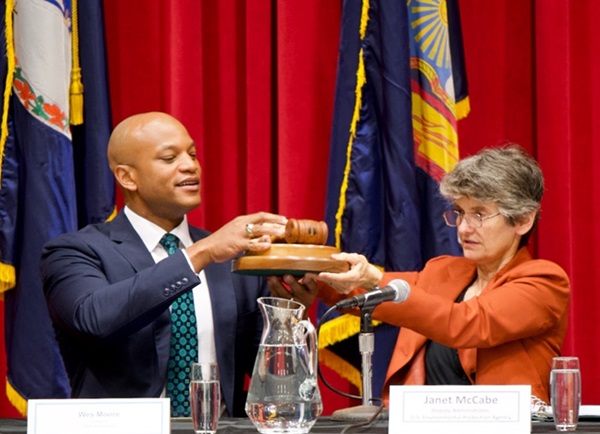Do you value local journalism? Support NottinghamMD.com today.
ANNAPOLIS, MD—This week, Governor Wes Moore was unanimously elected to serve as chair of the bipartisan Chesapeake Executive Council during a meeting hosted by the Environmental Protection Agency in Washington, D.C.. The council, which serves as the primary policy and leadership body of the formal Chesapeake Bay Partnership’s effort to restore the Chesapeake Bay, is comprised of the nine signatories to the 2014 Chesapeake Bay Watershed Agreement (PDF)—governors of the five watershed states, the mayor of Washington D.C., the administrator of the U.S. Environmental Protection Agency and the chair of the Chesapeake Bay Commission.
“The Chesapeake Bay belongs to everyone. It is a place of inspiration, source of economic strength, and a keystone of our environmental health,” said Gov. Moore. “We will grow our coalition and hold each other accountable for improving the health of the Bay. I believe in the power of partnership and if we follow the science, we can achieve our vision of a cleaner, greener, healthier Bay for all.”
2023 marks the 40th anniversary of the original Chesapeake Bay Agreement. Under the Moore-Miller Administration, Maryland is working to shift its Bay cleanup strategy to align with the latest scientific recommendations through several new initiatives. State agencies are pursuing more comprehensive restoration projects and partnering with community organizations to identify ways to improve shallow-water habitats to benefit fish and crabs and protect communities from flooding.
To accelerate progress toward the 2025 goals, Maryland is increasing outreach and technical assistance to farmers to reduce polluted runoff from agriculture and planting 5 million new trees—including 500,000 in cities—to reduce stormwater pollution, cool streams, and mitigate heat island effects. In the Bay, Maryland planted a record 1.7 billion water-filtering oysters this year and is working to finish a fifth large-scale oyster restoration project in the Manokin River Sanctuary.
In March, Governor Moore also called on the federal government to declare the expanding population of invasive fish species—including blue catfish, flathead catfish, and snakehead—to be an ongoing commercial fishery disaster in the Maryland waters of the Chesapeake Bay.
In July, Governor Moore announced a major policy shift in how Maryland will deploy state resources to improve water quality in local streams, the Chesapeake Bay, and the Atlantic Coastal Bays. Governor Moore signed two executive orders and outlined plans to provide more places for people to safely swim, better protect coastal areas from climate change, and increase fish and crab populations to improve economic opportunities for watermen and the state’s seafood industries.
Maryland Department of Natural Resources Secretary Josh Kurtz; Maryland Department of the Environment Secretary Serena McIlwain; and Pennsylvania Senator and Chair of the Chesapeake Bay Commission Scott Martin, Deputy Administrator of the U.S. Environmental Protection Agency Janet McCabe also attended today’s meeting. Members discussed ongoing work to reduce pollution and improve habitat conditions for living resources in the Bay watershed.


